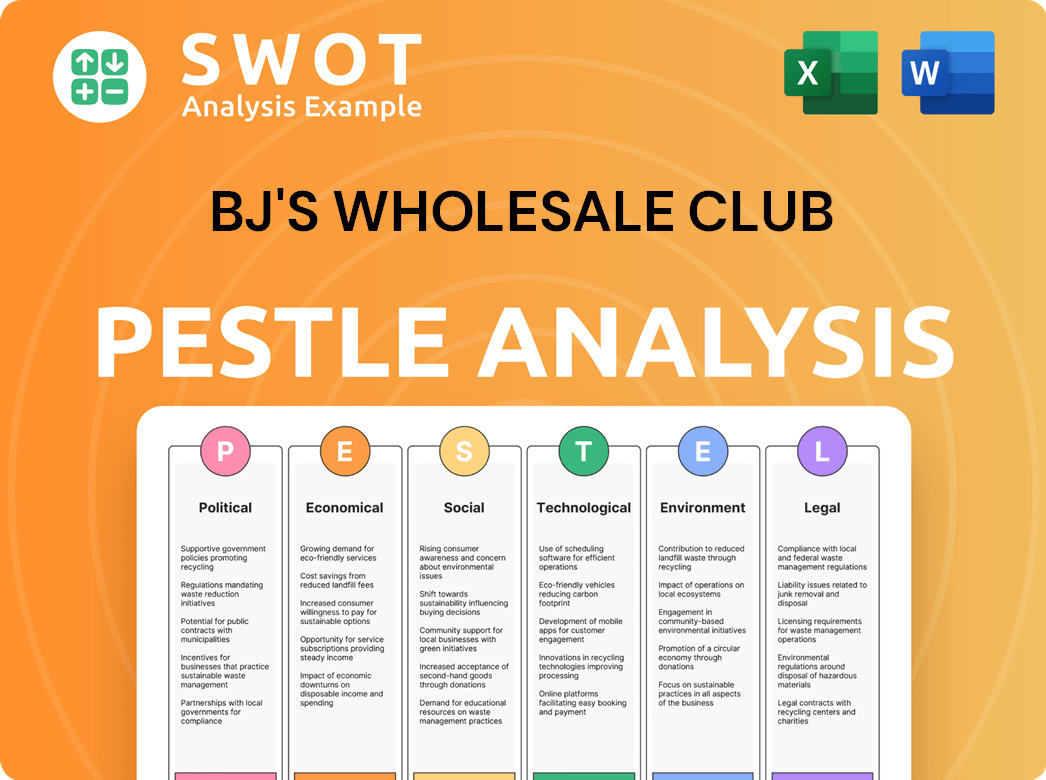BJ's Wholesale Club Bundle
Can BJ's Wholesale Club Thrive in Today's Retail Battlefield?
The retail world is a constant battleground, especially within the fiercely competitive warehouse club sector. BJ's Wholesale Club, a significant player in this arena, faces the challenge of adapting to changing consumer demands and the rise of e-commerce. Understanding BJ's Wholesale Club's position requires a deep dive into its BJ's Wholesale Club SWOT Analysis and its strategies for maintaining a competitive edge.

This exploration of BJ's Wholesale Club's competitive landscape will dissect its key rivals, conduct a thorough market analysis, and examine its unique differentiators within the retail industry. We will investigate the company's business strategy, including its pricing strategy and expansion plans, while also comparing it to wholesale club competitors like Costco and Sam's Club. Furthermore, we'll analyze BJ's Wholesale Club's financial performance and customer demographics to understand its future in the grocery market and online retail landscape.
Where Does BJ's Wholesale Club’ Stand in the Current Market?
BJ's Wholesale Club holds a distinct market position within the U.S. warehouse club sector. Primarily operating on the East Coast, it competes in the retail industry by offering a membership-based model. The company focuses on providing value through bulk purchases and discounted prices to both individual consumers and small businesses, differentiating itself in the competitive landscape.
The core operations of BJ's revolve around its extensive product lines, which include fresh and frozen groceries, general merchandise, electronics, and various services. These services range from optical centers to tire services, enhancing the overall value proposition for its members. This comprehensive approach supports its strategy to be a one-stop shopping destination for a wide array of needs.
BJ's value proposition centers on providing significant savings on a wide variety of products. This is achieved through bulk purchasing options and competitive pricing, making it attractive for budget-conscious consumers and small businesses. Further enhancing its appeal, BJ's has invested in digital transformation to provide services like "buy online, pick up in-club" and same-day delivery.
BJ's Wholesale Club is the third-largest player in the warehouse club space within the U.S., behind Costco and Sam's Club. While specific recent market share figures for 2024-2025 are not readily available, its established position is clear. This ranking indicates a strong presence in the wholesale club competitors market.
BJ's has a strong presence in the Northeast and Mid-Atlantic regions. Its strategy includes tailoring product assortments to regional preferences. This localized approach helps it compete effectively against larger rivals. This is a key part of its BJ's Wholesale Club business strategy.
In fiscal year 2023, BJ's reported total revenues of $19.3 billion. The company's net income reached $513.2 million in the same year. This financial stability allows BJ's to compete effectively. For more details, explore the Brief History of BJ's Wholesale Club.
BJ's has enhanced its e-commerce platform and offers services like "buy online, pick up in-club," and same-day delivery. These digital investments cater to evolving customer demands. This has strengthened its position in the wholesale club competitors market.
BJ's benefits from a strong brand recognition and a dense store presence in the Northeast and Mid-Atlantic regions. Its focus on regional preferences and omnichannel capabilities provides a competitive edge. This includes a focus on the BJ's Wholesale Club market share.
- Strong regional presence and brand recognition.
- Tailored product assortments to regional preferences.
- Investments in digital transformation and omnichannel services.
- Consistent financial performance and revenue growth.
BJ's Wholesale Club SWOT Analysis
- Complete SWOT Breakdown
- Fully Customizable
- Editable in Excel & Word
- Professional Formatting
- Investor-Ready Format

Who Are the Main Competitors Challenging BJ's Wholesale Club?
The competitive landscape for BJ's Wholesale Club is multifaceted, encompassing both direct and indirect rivals within the retail industry. Understanding the key players and their strategies is crucial for a comprehensive market analysis. The company faces significant challenges and opportunities in a dynamic market environment.
BJ's Wholesale Club operates in a competitive market, contending with established giants and emerging online retailers. The company's success depends on its ability to differentiate itself through pricing, product offerings, and customer experience. Analyzing the competitive landscape helps to identify strategic advantages and potential areas for growth.
The primary direct competitors for BJ's Wholesale Club in the wholesale club sector are Costco Wholesale Corporation and Sam's Club. These membership-based stores offer bulk purchasing options and compete for the same customer base. The competitive dynamics between these companies are shaped by factors such as purchasing power, operational efficiency, and brand loyalty.
Costco is a major competitor due to its vast scale and global presence. It is known for premium product offerings and strong brand loyalty. Costco's financial performance, such as the reported net sales of $58.45 billion for the first quarter of fiscal year 2025, indicates its market dominance.
Sam's Club, a division of Walmart, leverages Walmart's extensive resources. It offers competitive pricing and a wide array of products. Sam's Club reported a 4.6% increase in comparable sales, excluding fuel, in the fourth quarter of fiscal year 2024.
Supermarket chains like Kroger and Ahold Delhaize compete for grocery sales. They focus on convenience and diverse product selections. These retailers do not offer bulk pricing, but they compete for the same consumer spending.
Hypermarkets such as Walmart Supercenters and Target offer a one-stop-shop experience. They blend groceries with general merchandise. These stores compete by providing a wide variety of products under one roof.
E-commerce giants like Amazon, especially with Amazon Fresh and Whole Foods Market, pose an indirect threat. Consumers are increasingly shifting to online grocery shopping and home delivery. The rise of online grocery delivery services intensifies the competitive pressure.
Mergers and alliances, such as Amazon's acquisition of Whole Foods, have intensified competition. These create more integrated retail ecosystems. The competitive landscape is constantly evolving due to these strategic moves.
Beyond the direct competitors, understanding the broader market dynamics is essential. The Growth Strategy of BJ's Wholesale Club involves navigating these challenges and capitalizing on opportunities within the retail sector. The company's ability to adapt to changing consumer preferences and technological advancements will be critical for its long-term success. Key factors include pricing strategy, customer demographics, and expansion plans, all of which contribute to BJ's Wholesale Club's competitive advantages.
BJ's Wholesale Club's competitive position is influenced by several key factors.
- Pricing Strategy: Offering competitive prices on bulk items is crucial.
- Product Selection: Providing a wide range of products, including groceries and general merchandise.
- Membership Model: Attracting and retaining members through value and benefits.
- Operational Efficiency: Managing costs and maintaining an efficient supply chain.
- Customer Experience: Creating a positive shopping experience to foster customer loyalty.
BJ's Wholesale Club PESTLE Analysis
- Covers All 6 PESTLE Categories
- No Research Needed – Save Hours of Work
- Built by Experts, Trusted by Consultants
- Instant Download, Ready to Use
- 100% Editable, Fully Customizable

What Gives BJ's Wholesale Club a Competitive Edge Over Its Rivals?
Understanding the competitive landscape of BJ's Wholesale Club requires a deep dive into its strategic advantages. The company, a key player in the retail industry, has carved out a niche through its membership-based model and focus on providing value to its customers. This approach has allowed it to compete effectively against larger wholesale club competitors and other retail formats.
A comprehensive market analysis reveals that BJ's Wholesale Club's success hinges on several core strengths. These include a strategic product assortment, a strong focus on fresh food, and an emphasis on customer loyalty. These elements, combined with operational efficiencies, contribute to its ability to maintain a competitive edge in a dynamic market.
The company's financial performance and business strategy are closely tied to its ability to leverage these advantages. Its focus on member value and convenience has been crucial in driving growth and maintaining a loyal customer base. For more details on how the business generates revenue, see Revenue Streams & Business Model of BJ's Wholesale Club.
BJ's Wholesale Club offers a carefully selected range of products, including a higher proportion of national brands compared to some rivals. This appeals to members seeking value on familiar items. This strategy helps to attract and retain customers by providing a mix of well-known and private-label goods.
A significant advantage for BJ's is its emphasis on fresh food, including produce, meat, and deli items. These offerings are crucial in driving membership and encouraging repeat visits. Fresh food sales contribute significantly to overall revenue and customer satisfaction, differentiating BJ's from competitors that may focus more on non-perishable goods.
BJ's has a strong presence on the East Coast, allowing for efficient distribution and marketing tailored to local consumer preferences. This regional density enhances operational efficiency and enables the company to better understand and cater to the specific needs of its customer base. This focused approach supports customer loyalty and brand recognition.
The company has invested in enhancing its omnichannel capabilities, including its website, mobile app, and in-club pickup services. These improvements enhance member convenience and retention. This integration of online and in-store experiences is crucial for meeting the evolving demands of today's consumers.
BJ's Wholesale Club's competitive advantages include a curated product assortment, a focus on fresh food, and a localized market strategy. These elements are supported by strong brand equity and customer loyalty, fostered through its membership model. The annual membership fees provide a stable revenue stream, which helps offset operational costs. BJ's has also developed a strong private label program, offering high-quality products at competitive prices.
- Curated Product Assortment: Offers a mix of national brands and private-label goods.
- Fresh Food Focus: Drives membership and repeat visits.
- Localized Strategy: Enhances efficiency and caters to local preferences.
- Omnichannel: Improves member convenience and retention.
- Membership Model: Fosters loyalty and provides a stable revenue stream.
BJ's Wholesale Club Business Model Canvas
- Complete 9-Block Business Model Canvas
- Effortlessly Communicate Your Business Strategy
- Investor-Ready BMC Format
- 100% Editable and Customizable
- Clear and Structured Layout

What Industry Trends Are Reshaping BJ's Wholesale Club’s Competitive Landscape?
The competitive landscape for BJ's Wholesale Club is dynamic, shaped by industry trends, technological advancements, and evolving consumer preferences. Understanding these factors is crucial for assessing its market position and future prospects. A thorough market analysis reveals both the challenges and opportunities that BJ's Wholesale Club faces in the retail industry.
The company's success hinges on its ability to adapt to these changes while maintaining a strong value proposition for its members. The competitive landscape includes established players and emerging competitors, making strategic agility essential for sustained growth and profitability. Analyzing BJ's Wholesale Club's business strategy and financial performance provides insights into its ability to navigate these complexities.
Several key trends are influencing BJ's Wholesale Club. The rise of e-commerce and the integration of online and in-store experiences are crucial. Consumer demand for convenience, healthier options, and sustainable products is also growing. Furthermore, economic factors like inflation and supply chain issues play a significant role.
BJ's Wholesale Club faces several challenges. Competition from e-commerce giants and traditional retailers is intensifying. Rising labor and transportation costs can squeeze profit margins. Attracting and retaining members in a saturated market requires constant innovation. The company needs to manage these pressures effectively.
Significant opportunities exist for BJ's Wholesale Club. Expanding its omnichannel retail model can enhance member convenience and loyalty. Entering new geographic markets and innovating with product offerings, such as organic foods, can attract new customers. Strategic partnerships can also create new revenue streams.
To thrive, BJ's Wholesale Club is likely to continue investing in digital infrastructure and optimizing its supply chain. Refining its product assortment to meet consumer demands and exploring club expansion are also key. The company's focus on same-day delivery services and personalized digital experiences is crucial for its competitive edge.
BJ's Wholesale Club is focusing on several key strategies to maintain its competitive position. These include enhancing its digital capabilities, optimizing its supply chain, and expanding its club footprint. The company is also working on refining its product assortment to align with evolving consumer preferences and exploring strategic partnerships.
- Investing in digital platforms to improve the online shopping experience.
- Optimizing supply chain logistics to reduce costs and improve efficiency.
- Expanding into new markets to increase its customer base and revenue.
- Focusing on product innovation to meet changing consumer demands.
BJ's Wholesale Club Porter's Five Forces Analysis
- Covers All 5 Competitive Forces in Detail
- Structured for Consultants, Students, and Founders
- 100% Editable in Microsoft Word & Excel
- Instant Digital Download – Use Immediately
- Compatible with Mac & PC – Fully Unlocked

Related Blogs
- What are Mission Vision & Core Values of BJ's Wholesale Club Company?
- What is Growth Strategy and Future Prospects of BJ's Wholesale Club Company?
- How Does BJ's Wholesale Club Company Work?
- What is Sales and Marketing Strategy of BJ's Wholesale Club Company?
- What is Brief History of BJ's Wholesale Club Company?
- Who Owns BJ's Wholesale Club Company?
- What is Customer Demographics and Target Market of BJ's Wholesale Club Company?
Disclaimer
All information, articles, and product details provided on this website are for general informational and educational purposes only. We do not claim any ownership over, nor do we intend to infringe upon, any trademarks, copyrights, logos, brand names, or other intellectual property mentioned or depicted on this site. Such intellectual property remains the property of its respective owners, and any references here are made solely for identification or informational purposes, without implying any affiliation, endorsement, or partnership.
We make no representations or warranties, express or implied, regarding the accuracy, completeness, or suitability of any content or products presented. Nothing on this website should be construed as legal, tax, investment, financial, medical, or other professional advice. In addition, no part of this site—including articles or product references—constitutes a solicitation, recommendation, endorsement, advertisement, or offer to buy or sell any securities, franchises, or other financial instruments, particularly in jurisdictions where such activity would be unlawful.
All content is of a general nature and may not address the specific circumstances of any individual or entity. It is not a substitute for professional advice or services. Any actions you take based on the information provided here are strictly at your own risk. You accept full responsibility for any decisions or outcomes arising from your use of this website and agree to release us from any liability in connection with your use of, or reliance upon, the content or products found herein.